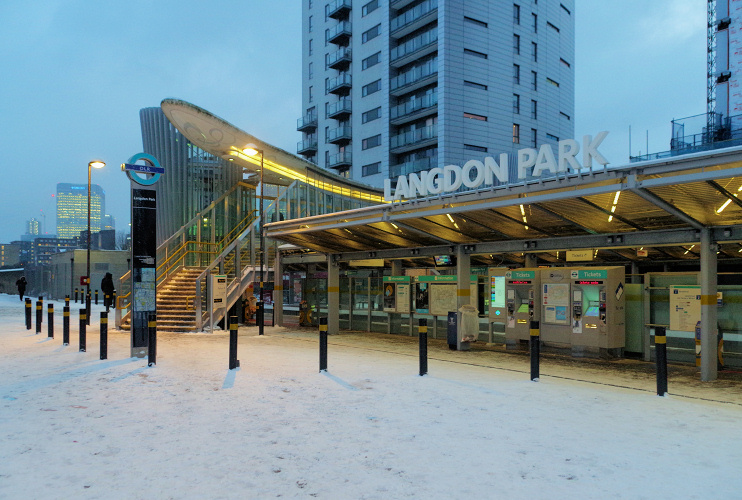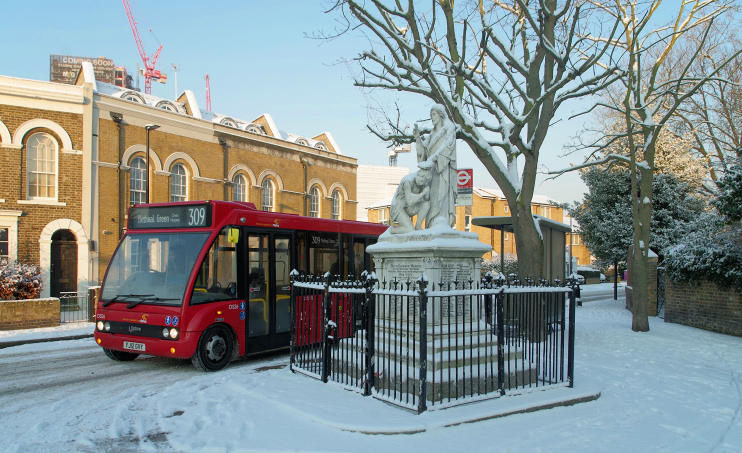Langdon Park
Langdon Park, Tower Hamlets
A conservation area, open space and Docklands Light Railway station in north-east Poplar

Well into the first half of the 19th century there was almost nothing here except a track called Bow Lane (now St Leonard’s Road and Uamvar Street), which led to Bromley-by-Bow’s parish church of St Mary with St Leonard.
Most of the locality was densely built up with terraced housing after the North London Railway opened in 1850. At this time there was a significant Irish community living here.
The church of St Michael and All Angels was built in 1864–5 in Early English Gothic style with polychrome detailing and a prominent tower that forms a local landmark. The church could seat a thousand worshippers.
St Michael and All Angels’ boys’ school was in existence by 1870 and it had become Byron Street school by 1882. Rebuilt in 1907, the school was later renamed in honour of Edmund Hay Currie.
From 1884 until 1944 South Bromley station stood at the eastern end of Rifle Street.
Poplar borough council built the low-rise Teviot estate after the Second World War and added a group of nine-storey blocks in 1954–6.
In 1959 the Blackwall Tunnel northern approach road was constructed parallel to St Leonard’s Road and large areas of the neighbourhood were cleared. The approach road effectively divorced this locality from the rest of South Bromley.
A recreation ground was created in stages from the late 1950s in place of the houses of Cobden Street and Woodin (formerly Wellington) Street, many of which had been damaged in the Blitz. It’s not clear to Hidden London why the name Langdon Park was chosen for this new open space but it may have honoured Father CG Langdon, who was vicar of St Michael’s church in the 1920s. Langdon was a pacifist and a socialist, involved with George Lansbury and the Poplar rates rebels. In 1965 Hay Currie school absorbed Limehouse’s Sir Humphrey Gilbert school and became Langdon Park.
St Michael and All Angels’ church was declared redundant in 1978 and later became the flats of St Michael’s Court. The conversion involved major changes to the interior, “which is now deprived of special interest,” according to the building’s grade II list entry.
By the late 1980s the Teviot estate had acquired a miserable reputation for isolation and poverty – and for white racism directed against the area’s growing Bangladeshi community. At one time the estate was said to have had the highest incidence of racial attacks in the country.

The Langdon Park conservation area was designated in 1990 and extended to the north-west in 2008. Its focal (though not central) point is St Michael’s Court, together with its grounds and the former vicarage. The photo above shows the grade II listed war memorial (1920) in front of the vicarage and, to its left, a locally listed terrace of Georgian-style houses built in the 1850s. Dating from the same period, the former St Leonard’s Arms is also locally listed. The pub closed in 1988 and was converted to flats in 2002.
Most of the Teviot estate was transferred to the Poplar HARCA housing association in 1998, after which a combination of refurbishment, demolition and redevelopment took place. The remainder of the estate was transferred to Poplar HARCA in 2007.
Created as part of the ‘sustainable communities initiative’, Langdon Park station opened in 2007. Local councillor Kevin Morton called the £7 million project, “a key step in breaking down the social Berlin Wall between Poplar and Docklands.” Incidentally, when the station was first mooted – back in 1983 when the DLR was originally being planned – it was to have been called Carmen Street, which is an indication of how ‘nameless’ this locality was at the time.
Langdon Park school is now a mixed community comprehensive that draws its students from a relatively local catchment area. In 2016 Ofsted reported that the majority of the school’s pupils were of Asian or Asian British heritage – a change from previous reports, which had found a more even mix of white, black and Asian ethnic backgrounds. The 2016 report also noted that “a far higher than average proportion of pupils [are] eligible for the pupil premium (additional government funding for disadvantaged children and children looked after).” English was spoken as an additional language by 85 per cent of pupils in the 2016–17 academic year.
After having been expelled from four other schools, the hip-hop artist Dizzee Rascal attended Langdon Park, where he was apparently excluded from every class except music. Encouraged by his teacher, he began making music on the school’s computer. “What emerged from Langdon Park’s music room may well be the most original sound heard in British music for the best part of a decade,” wrote Alexis Petridis in the Guardian in 2003.
Postal district: E14
Further reading: Eileen Baillie, Shabby Paradise: The Autobiography of a Decade, Hutchinson, 1958 (a memoir of St Michael’s parish in the early years of the 20th century)
Recommended PDF: Langdon Park conservation area
See also: South Bromley – and London’s other Langdon Park
